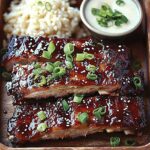Description
Tender and flavorful pork spareribs braised in a sticky, sweet, and savory Asian-inspired glaze.
Ingredients
Scale
- 4 pounds pork spareribs, cut into individual ribs or racks
- 2 tablespoons vegetable oil
- 1 large onion, chopped
- 4 cloves garlic, minced
- 1 inch ginger, peeled and grated
- 1 cup soy sauce (low sodium preferred)
- 1/2 cup honey
- 1/4 cup rice vinegar
- 2 tablespoons brown sugar, packed
- 2 tablespoons sesame oil
- 1 tablespoon sriracha (or more, to taste)
- 1 teaspoon ground ginger
- 1/2 teaspoon garlic powder
- 1/4 teaspoon red pepper flakes (optional)
- 2 tablespoons cornstarch
- 1/4 cup cold water
- Sesame seeds
- Chopped green onions
Instructions
- Prepare the Ribs: If you bought a full rack of spareribs, you’ll need to cut them into individual ribs or smaller racks. I prefer cutting them into smaller racks of 3-4 ribs each, as they’re easier to handle and cook evenly. Pat the ribs dry with paper towels. This helps them brown nicely.
- Sear the Ribs (Optional but Recommended): While this step isn’t strictly necessary, searing the ribs before braising adds a wonderful depth of flavor. Heat the vegetable oil in a large, heavy-bottomed pot or Dutch oven over medium-high heat. Working in batches, sear the ribs on all sides until nicely browned. Don’t overcrowd the pot, or the ribs will steam instead of sear. Remove the seared ribs from the pot and set aside.
- Sauté Aromatics: Reduce the heat to medium. Add the chopped onion to the pot and cook until softened and translucent, about 5-7 minutes. Add the minced garlic and grated ginger and cook for another minute, until fragrant. Be careful not to burn the garlic.
- Return Ribs to the Pot: Place the seared ribs back into the pot with the onions, garlic, and ginger.
- Combine Glaze Ingredients: In a medium bowl, whisk together the soy sauce, honey, rice vinegar, brown sugar, sesame oil, sriracha, ground ginger, garlic powder, and red pepper flakes (if using).
- Pour Glaze Over Ribs: Pour the glaze over the ribs in the pot. Make sure the ribs are mostly submerged in the liquid. If necessary, add a little water or chicken broth to cover them.
- Bring to a Simmer: Bring the mixture to a simmer over medium heat. Once simmering, reduce the heat to low, cover the pot, and let the ribs braise for 2-3 hours, or until they are very tender and the meat is easily falling off the bone. Check the ribs occasionally and add more liquid if needed to prevent them from drying out. The braising time will depend on the size and thickness of your ribs.
- Remove Ribs from Pot: Once the ribs are tender, carefully remove them from the pot and place them on a baking sheet lined with parchment paper or foil.
- Thicken the Glaze: In a small bowl, whisk together the cornstarch and cold water to create a slurry. Pour the cornstarch slurry into the pot with the braising liquid. Bring the liquid to a simmer over medium heat and cook, stirring constantly, until the glaze has thickened to your desired consistency. This should only take a few minutes.
- Glaze the Ribs: Brush the thickened glaze generously over the ribs on the baking sheet.
- Broil or Bake (Optional): For an extra sticky and caramelized finish, you can broil the ribs for a few minutes, watching them closely to prevent burning. Alternatively, you can bake them in a preheated oven at 375°F (190°C) for 10-15 minutes, or until the glaze is bubbly and caramelized.
- Serve: Garnish the ribs with sesame seeds and chopped green onions, if desired. Serve immediately and enjoy! These ribs are fantastic with steamed rice, noodles, or your favorite Asian-inspired side dishes.
Notes
- Choose the Right Ribs: Spareribs are the classic choice for this recipe, but baby back ribs will also work. Spareribs are meatier and have more fat, which makes them incredibly flavorful and tender when braised.
- Don’t Skip the Searing: Searing the ribs adds a wonderful depth of flavor that you won’t get if you skip this step. It’s worth the extra effort!
- Adjust the Spice Level: If you’re sensitive to spice, start with a smaller amount of sriracha and add more to taste. You can also omit the red pepper flakes altogether.
- Control the Heat: Braising is a gentle cooking method, so it’s important to keep the heat low and slow. This will ensure that the ribs become incredibly tender without drying out.
- Don’t Overcrowd the Pot: When searing the ribs, work in batches to avoid overcrowding the pot. Overcrowding will lower the temperature of the oil and cause the ribs to steam instead of sear.
- Adjust the Glaze Consistency: If you prefer a thicker glaze, use a little more cornstarch. If you prefer a thinner glaze, use a little less.
- Let the Ribs Rest: After braising, let the ribs rest for a few minutes before glazing them. This will allow the juices to redistribute, resulting in even more flavorful ribs.
- Broiling Tips: When broiling the ribs, keep a close eye on them to prevent burning. The glaze can caramelize quickly under the broiler, so it’s important to watch them carefully.
- Make Ahead: You can braise the ribs ahead of time and store them in the refrigerator for up to 2 days. When you’re ready to serve, simply glaze them and broil or bake them until heated through.
- Freezing: Cooked ribs can be frozen for up to 2 months. Wrap them tightly in plastic wrap and then in foil to prevent freezer burn. Thaw them overnight in the refrigerator before reheating.
- Prep Time: 20 minutes
- Cook Time: 150 minutes
